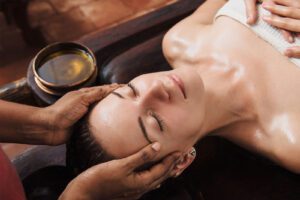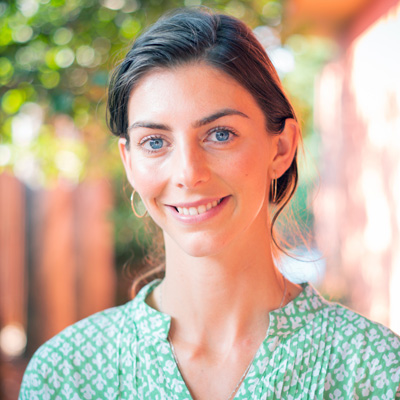
By Beatrice Voss, CAP, RYT-200
Ayurvedic medicine categorizes individuals into three main ‘types’ according to the predominant qualitative tendencies of their anatomy and physiologies. Unlike modern systems of medicine which rely on averages and treat most people by the same standards, Ayurveda, India’s ancient system of healing, treats on an individual basis.
This understanding of constitutional differences between individuals was also understood in ancient western medicine with the concept of the humors, and in traditional chinese medicine with their concepts of the five elements. It can explain why the same remedy is beneficial for one individual experiencing disease, while it may not help or even worsen the condition in others.
The Ayurvedic constitution, also called ‘prakriti’ or fundamental nature, is determined by the unique composition of the five great elements and three ‘doshas’ (biological energies) in their being from birth and throughout life. This constitution stays constant throughout the span of life, but the doshas may increase due to external influences, manifesting as ‘vikruti’; imbalance or disease.
This famous vedic sutra states that all material substances are made up of the five great elements. Those elements are Space, Air, Fire, Water and Earth. The first element, Space or Akasha, is clear, light, soft and expansive. In the body it is associated with cavities, pores and channels. The air element, Vayu, corresponds to all that moves and breathes within the body as well as communications at the cellular and systemic level; such as the shooting of electrical impulses through nerves. The fire element, Agni, is represented in all transformational processes in the body such as intelligence, digestion, the generation of body heat and sensation. The water element, Apas, is predominant in all the fluid tissues of the body; blood and lymph as well as in the inter and extracellular spaces throughout the body. Water is the universal solvent for all chemical reactions and processes. Finally, the earth element, Prthvi, composes the physical structure and solid mass of the body tissues; nails, teeth, muscles and the skeleton.
The concept of the tridosha in Ayurveda are groupings of these original, great elements into pairs; Vata is the space and air elements, Pitta is fire and water elements and Kapha is water and earth elements. These three biological ‘humors’ are responsible for the proper functioning of the body when in balance, and disease when they become imbalanced.
Everybody has all five elements in their body, and as such all three doshas, working together to sustain life. What the Prakruti really refers to is the proportion and predominance of one or two of these elements or doshas, that leads to them being classified as either Vata, Pitta or Kapha predominant. As discussed, this predominance is set at the moment of birth and does not change throughout life, other than in rare circumstances. While the doshas may fluctuate in response to foods we eat, travel, or activities, our constitutional baseline does not change. In order to maintain good health, each individual needs to work to restore this original ratio of the doshas in their constitution.
The physical appearance of the body is used, amongst other methods of visual and tactile diagnosis, to determine an individual’s doshic predominance; whether they are more Vata, Pitta or Kapha. Dual doshic and even a balanced Triple doshic prakruti is possible alongside a single dosha being predominant.
The Ayurvedic science of akruti refers to the look of a person, which to the trained eye of an Ayurvedic practitioner or doctor, will reveal particular tendencies and the deeper nature of a person beyond their present state of health or imbalance. The Akruti includes the general shape of the body, type of musculature, distribution of fat as well as height and weight. More specifics come in with skin and hair color and texture, as well as the color and quality of various organs such as the eyes.
Read on to determine your ayurvedic body type! As you do, it is important to consider general truths over the lifespan, as temporary manifestations of some of these items may be more indicative of vikruti; temporary states of imbalance as opposed to the underlying constitution. For example, if over the course of your life you have generally been slim, but during pregnancy put on a lot of weight and even developed conditions such as gestational diabetes; that would reflect more of a temporary Kapha accumulation or condition, not your deeper constitution.
Sometimes, especially with long lingering doshic imbalance, it can be difficult to identify the true prakruti of a person based only on physical appearance. In these cases, consider having your pulse read by an Ayurvedic practitioner or doctor.
Given the dry, cold, light, rough, subtle, mobile, clear qualities of Air and Space elements, the Vata individual will have bodies with a propensity to these qualities in its physical manifestation.
The Vata body type is typically either tall or short, not average height. This reflects the irregular quality of Vata. The irregular quality of Vata may result in some asymmetry of the face or other structures and the teeth may be large and have spaces in between them. The Vata face can be elongated, thin and long. A thin body with little weight on it reflects the laghu, light quality of Vata’s Air and Space elements. Vata body types often have difficulty gaining weight for the same reason. Often, Vata body types will be highly mobile, finding it hard to sit still and be calm. There may be twitching or jostling of the feet and a general restlessness about them. They may walk quickly and sporadically trip or fall because of the lack of sthira or grounded quality. Vata body types generally enjoy movement; exercise, running, dance, yoga but they need to be careful not to overdo it!
Because of the dry quality of Vata, Vata predominant individuals can tend to have dry skin and hair. The irregular quality can create frizzy, unruly or curly hair. Vata types tend to have darker skin than individuals with Kapha and Pitta predominance.
Being composed of fire and water elements, the attributes of Pitta are hot, light, sharp, oily, spreading and pungent thus these qualities will be more present in the Pitta individual overall. Pitta is associated with red and yellow colors, so Pitta types can have more of a reddish complexion. They can be prone to sensitive skin (especially to sunlight) with more of a tendency to have moles and freckles. The hair can be a fiery red color or have reddish hues. The strong fire and sharpness of mind in Pitta individuals can cause premature graying or balding of the hair. The yellow color can emerge in the form of yellowish teeth, which can also be sharp in shape. The nose and chin can be sharp while the face has a heart shape with a tapering chin.
Pitta types are often sensitive and have generally delicate bodies and constitutions. They have moderate strength and, like Vata types, should not work or push themselves too hard physically.
The Pitta body type is more of a moderate build with a good musculature and average height. Pitta types generally have a consistent and stable, moderate weight with a good digestive capacity. Pitta also governs the luster of the body so when in balance, the skin can have a slightly oily, shining complexion.
The qualities of Kapha are heavy, smooth, stable, sticky, cool, and dense. As such, Kapha body types tend to be overweight or have difficulty losing weight. They tend to have bigger builds with larger bones and joints. The feet and hands will be wider and the shape of the face tends to be round. Kapha types have thick hair and strong nails. They have beautiful, big, glossy eyes and a wide button nose. Kapha types can have big lips compared to Vata and Pitta types and the skin can be oily but cool, with a pale color.
Of all the three types, Kapha types have the most resilient and stable physiology. They can easily tend to an excess of the qualities of heaviness, manifesting as lethargy, stagnation and excess growth.
As mentioned before, individuals can have a tendency to multiple doshas. If, as you read this you identify multiple doshas in play you may have a dual or even triple doshic body type.
We can go one step further after identifying our primary ayurvedic body type; whether that be Vata, Pitta or Kapha and use the principle of ‘like increases like’ or opposites balance to guide the movement practices that can be most supportive to our body type.
For Vata people, who tend towards dryness, excess mobility and coldness, warm, grounding, fluid and gentle exercise can be very supportive. Examples include gentle yoga in a gently heated space, walking and swimming. Vata types should never push themselves to full capacity as they can tend towards depletion and exhaustion. The ancient vedic texts state that exercising to half capacity, just until the heart rate is noticeably elevated or sweat forms on the brow is sufficient.
For Pitta body types, exercise is seen to be like ‘food’ for their more developed musculature. Moderate exercise is indicated, again just like Vata not pushing themselves to extremes as they can be delicate and get ‘burned out’ easily. Because of Pitta’s hot, oily and sharp qualities, exercises like dance, swimming or moderate yoga in a well ventilated space can work well.
Kapha is the heaviest, most stable and static of the three doshas and can tend towards lethargy, heaviness, stagnation and accumulation. It’s qualities are cool, sticky and can become stuck so the best exercise for Kapha is opposite in nature; heating, stimulating of the circulatory systems and vigorous in intensity. Good types of exercise can be warm yoga at a faster pace, cardio and more stimulating pranayamas such as Bhastrika and Kapalabhati.
Surya Namaskar (yogic sun salutations) is seen as a complete exercise and can be modified to accommodate each dosha.

Beatrice has studied under Vasant Lad, and is passionate about sharing the timeless wisdom of Ayurveda to help others heal themselves.